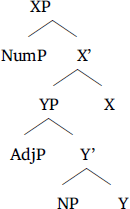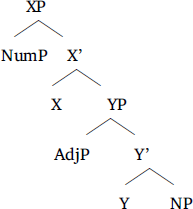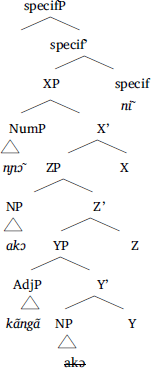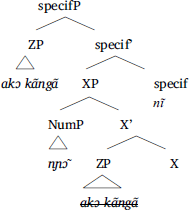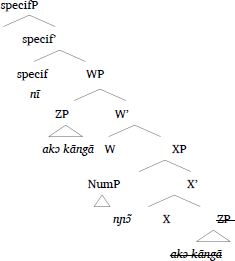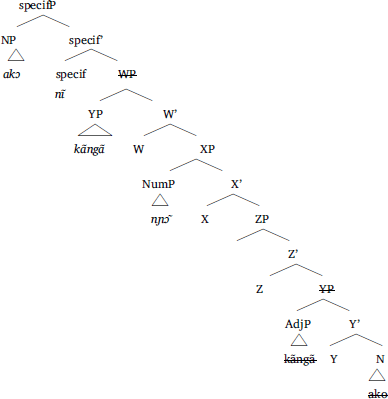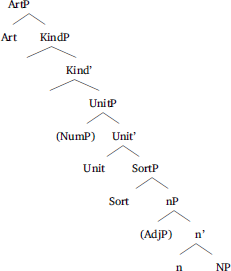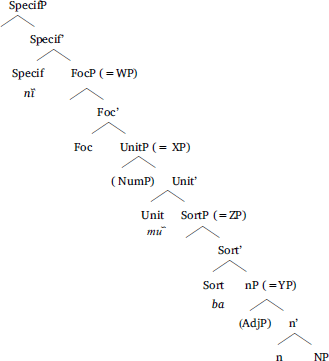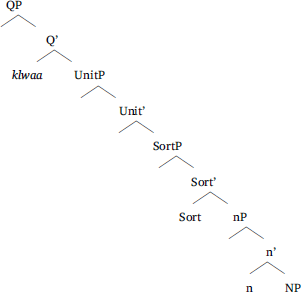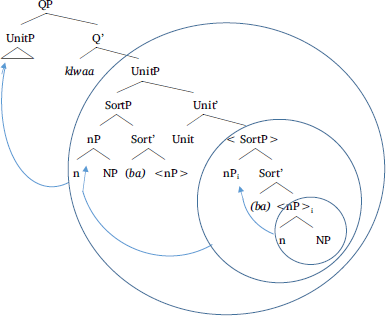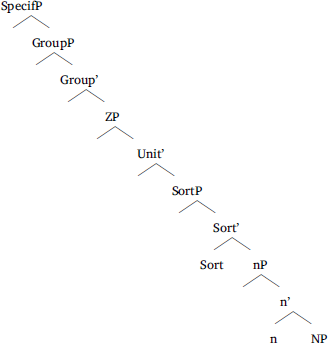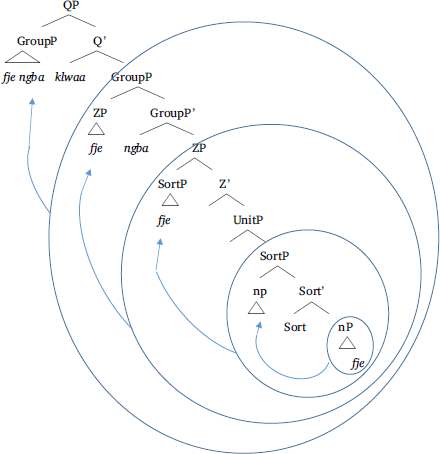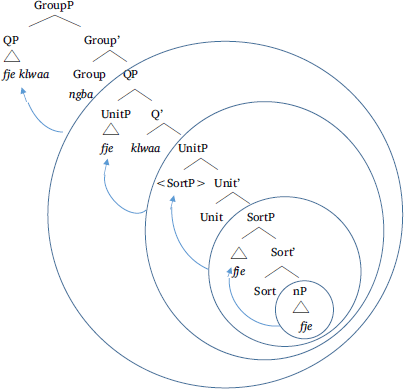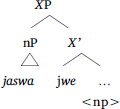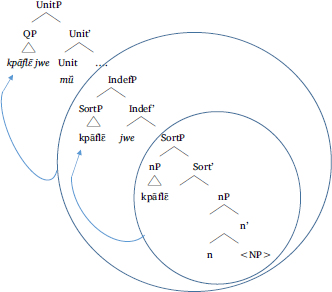1. Introduction
1.1 A brief introduction to Baule
Baule [‘bauleɛ] is a language of the Niger-Congo Kwa family spoken in Ivory-Coast, mostly in the central and southern parts of the country. According to WorldAtlas (2017), the language counts approximately 1.2 million speakers.1 The language also has several dialectal variants, of which the Kode [kodɛ] dialect will be the object of our discussion. Kode is spoken in the “Northwestern corner of the Baule region” (Timyan 1977:15), that is, the area of Béoumi. Kode shares with Central Baule most of its features. It nevertheless exhibits variation at the level of the lexicon, but also at the syntactic level. Here, we will be using the term Baule whenever the variants do not exhibit any distinction (that is, the data is compatible with both Central Baule and Kode), and we will specifically use the term Kode when the data belongs exclusively to the Baule-Kode variant. In this section, we give a brief description of the main properties of the language.
Baule is a tonal language, with 5 contrasting tones and nasal-oral vowel contrast (see a.o. Timyan 1977; Ahoua 1996; Konan 2019). Typically, the language will exhibit the following contrasting pairs (where the diacritic ʹ indicates high tone, ˉ middle tone, ˋ low tone, ͝ indicates rising tone and ͡falling tone):2
| (1) | a. | [saʹ ] ‘affair’ vs [saˋ] ‘ginger’ |
| b. | [blaʹ] ‘well’ vs [blaˉ ] ‘woman’ | |
| c. | [bwe͝ ] ‘nose’ vs [bwe͡ ] ‘half’ | |
| [Konan 2019: 129] |
Baule is described as an SVO language (see Timyan 1977, Konan 2019):
- (2)
- Abo
- Abo
- klo
- love
- able
- corn
- ‘Abo loves corn’.
- [Konan 2019: 166]
The verb bears no agreement or tense marking. In addition to tonal mode marking,3 the verb can also bear the aspectual prefixes a- (for perfective) and su- (imperfective or progressive) and a “factual past” suffix -li, which expresses “an action, process or state which has actually occurred and is a fact of the world.” (Timyan 1977: 229). The suffix -li has an allomorph, realized as the reduplicated final vowel of the verb if it is not sentence final. The default, non-marked aspect yields a habitual, general statement:
- (3)
- a.
- Ngo
- Ngo
- a-bo
- perf-peel
- agba.
- manioc
- ‘Ngo has pealed the manioc.’
- b.
- Abo
- Abo
- su-bo
- prog-peel
- agba.
- manioc
- ‘Abo is peeling the manioc.’
- c.
- Abo
- Abo
- bo-o
- peel-fact.pst
- agba.
- manioc
- ‘Abo peeled the manioc.’
- d.
- Abo
- Abo
- bo
- peel
- agba.
- manioc
- ‘Abo peels manioc.’
The contrast between perfective and factual past is illustrated in (4):
- (4)
- a.
- Kofi
- kofi
- a-wɔ
- perf-go
- Bouake.
- Bouake
- ‘Kofi has gone to Bouaké (and is still there)
- b.
- Kofi
- kofi
- wɔ-ɔ
- go-fact.pst
- Bouake.
- Bouake
- ‘Kofi went to Bouaké (no indication of where he is now).’
- [adapted from Timyan 1977: 231]
There is no number agreement on the verb either:
- (5)
- me
- pro.3pl
- a-fa
- perf-take
- mi
- pro.1sg
- sika.
- money
- ‘they took my money’
- [Konan 2019: 210]
Nouns bear no singular/plural marking:
- (6)
- nãnĩ
- ‘cow/cows’
Baule has six personal pronouns, (1,2,3 sg, 1,2,3 pl). They can function as full pronominal subjects (7a, b). They can also co-occur, as a resumptive pronoun, along with the full nominal subject.4 Clearly, the presence of the 3rd pl pronoun me in Kode (be in Central Baule) signals plurality (7c). However, the absence of me/be is not a mark of singular, but only indicates that number is unspecified (7d).
- (7)
- a.
- ɛ
- pro.3sg
- wɔ
- go
- sukulu.
- school
- ‘s/he goes to school.’
- b.
- me
- pro.3pl
- wɔ
- go
- sukulu.
- school
- ‘They go to school.’
- c.
- ba
- child
- me
- pro.3pl
- wɔ
- go
- sukulu.
- school
- ‘The children go to school.’
- d.
- ba
- wɔ
- sukulu.
- ‘The/a child/children go(es) to school.’
Nouns may be marked for specificity with the marker nĩ, as in (8) below, a property which will be discussed in more detail in this paper:
- (8)
- a.
- waka
- ‘tree/trees’
- b.
- waka
- tree
- nĩ
- spec
- ‘the/a (specific) tree/trees’
Adjectives and numerals follow the noun they modify:
- (9)
- a.
- swa
- house
- dã
- big
- ‘big house’
- b.
- aofwe
- stranger
- kpa
- good
- ‘good stranger’
- [Timyan 1977:120]
- c.
- waka
- tree
- kpe
- short
- nsã
- three
- ‘three short trees’
- [adapted from Timyan 1977: 121]
The order within the noun phrase, as given in Timyan (1977), is the following:
| (10) | Noun + Adjective + Numeral (/quantifier) + demonstrative + nĩ |
Note that this order corresponds to one of the few orders observed in Greenberg’s universal 20 (Greenberg 1963) and viewed as one of the most common orders, as discussed at length in Cinque (2005).
The data provided and discussed in this paper has three main sources. First, as mentioned explicitly, the authors rely on the rich and detailed data provided in Timyan (1977). The rest of the data comes in part from corpora recorded, transcribed, annotated by Yannick Konan in various villages in the Béoumi area and available in Konan (2019), and in part from Yannick Konan, who is a native speaker of the Kode variant of Baule, as well as from individual Kode-speaking informants.
1.2 The problem
Baule has two adnominal quantifiers which participate in universal quantification, ngba (glossed as ‘all’) and klwaa (‘every’):
- (11)
- a.
- Abo
- Abo
- wɔ
- go
- sukulu
- school
- kisje
- Monday
- cɛ̃
- day
- ngba.
- all
- ‘Abo goes to school all of Monday/on all Mondays.’
- b.
- Abo
- Abo
- wɔ
- go
- sukulu
- school
- kisje
- Monday
- cɛ̃
- day
- klwaa.
- every
- ‘Abo goes to school every Monday.’
Both ngba and klwaa are post-nominal. As shown by the glosses, they both quantify over the noun but they have different interpretations. While ngba yields the interpretation of ‘the whole of Monday’ or ‘the entire Monday’, klwaa splits the set into its individual atoms. The examples in (12) and (13) further illustrate this distinction:
- (12)
- Aya
- Aya
- ma
- give
- ba
- child
- ngba
- all
- aljɛ.
- food
- ‘Aya gives food to all the children’.
In (12), ngba follows the noun ba (‘child’). The quantifier bears on the nominal it immediately follows, and the interpretation is that all the recipients (as a group) receive food without any exception.
- (13)
- Aya
- Aya
- ma
- give
- ba
- child
- klwaa
- each
- aljɛ.
- food
- ‘Aya gives food to every child.’
Similarly, (13) shows that the quantifier klwaa (‘every’) follows the noun ba (‘child’). The interpretation is that every child, taken individually, will receive food from Aya, maybe in different food-giving events. Again, the quantifier bears only on the nominal preceding it. Moreover, the interpretation shows that klwaa operates as an ‘individuator’.
Baule also has various elements expressing existential quantification. The element jwe (‘some’), when it occurs after a nominal expression (noun or pronoun), is interpreted as an indefinite, and may be glossed as ‘some (undefined, unspecific)’:
- (14)
- a.
- Jaswa
- man
- jwe
- some
- klo
- like
- loto.
- car
- ‘Some man likes cars.’
- b.
- me
- pro.3.pl
- jwe
- some
- klo
- like
- utře
- fight
- třa su.
- much
- ‘Some (of them) like too much fight.’
We observe that jwe follows the noun jaswa (‘man’) and the 3rd person plural pronoun me (‘they’) respectively in (14a) and (14b).
The problem arises from the observation that in Baule, quantifiers can combine in an unexpected way. First, the universal quantifiers klwaa and ngba may occur together to form some complex quantification. The nominal element precedes the sequence of quantifiers:
- (15)
- alwa
- dog
- di-i
- eat-fact.pst
- srã
- human
- klwaa
- every
- ngba
- all
- akɔ
- chicken
- ‘The dog has eaten the chicken of absolutely all the people’
- (=lit: of all of every human)
Second, the existential jwe can combine with nĩ, a “specifier” or mũ, an “individuator” following Timyan’s (1977) terminology. Again, the sequence follows the nominal element it quantifies over (note that Kode uses a reduced form of the specifier nĩ, transcribed here as ’n):
- (16)
- a.
- kpãflɛ̃
- boy
- jwe
- some
- nĩ
- spec
- si able
- dance
- klɔ̃’n / klɔ̃- nĩ
- village-spec
- nũ.
- in
- ‘some boy dances in the village.’
- b.
- kpãflɛ̃
- boy
- jwe
- some
- mũ
- ind
- siable
- dance
- klɔ̃’n /klɔ̃- nĩ
- village-spec
- nũ.
- in
- ‘some boys dance in the village.’
The combination of various quantifiers produces complex quantification, and raises the following question, which we address in this paper: given the properties of individual quantifiers in Baule and their unexpected combinatorial possibilities, how do we account for their distribution and their contribution to the interpretation of quantified expressions?
In this paper, we propose an approach to quantified nominal expressions which builds on a structure-interpretation mapping. Therefore, any attempt at answering this question inevitably raises another one: if the interpretation of quantifiers is linked to their structural constraints, what is the syntax of the Baule DP?
Section 2 is a brief overview of both the theoretical framework we adopt and the existing literature on Niger-Congo languages in terms of quantification. Section 3 offers a discussion of the structure of the Baule DP, a domain which is, to our knowledge, yet unexplored. With the structure of the DP in mind, we then turn, in Section 4, to universally quantified DPs, and their various combinatorial possibilities. Section 5 looks at existentially quantified DPs. Finally, Section 6 offers a brief summary of our findings and introduces a number of yet unexplored quantifiers in Baule.
2 Theoretical background
2.1 Theoretical framework
2.1.1 Syntax
In order to approach quantification in Baule, we assume a syntactic structure based on Kayne’s (1994) antisymmetry. Kayne proposes that languages build up from an underlying asymmetrical structure which is head initial. In other words, even if surface strings exhibit a complement-head word order, the latter is derived by movement of the object to dedicated hierarchically higher (and hence linearly leftward) positions with respect to the head. We show below how the Baule DP is compatible with this approach.
We further assume Cinque’s (2005) analysis of the DP. Cinque re-examines Greenberg’s Universal 20 (Greenberg 1963; Hawkins 1983) and proposes a derivational account of the attested orders of demonstrative, numeral, adjective and noun in various languages. He argues that the word order variations within the DP found across languages can be accounted for given (i) a basic order Dem-Num-Adj-N and (ii) movement of the noun phrase around these modifiers. His main argument to propose a movement analysis rests on the observation that languages offer “essential left-right asymmetry in word order possibilities” (2005: 316).
Finally, we also use Szabolcsi’s (1994; 1997) and Beghelli’s (1995) approach to quantifiers, which argues that the structural organization of the clause is built on intrinsic properties of individual items, and that quantifiers occur in various positions because they bear unique and identifiable features associated with their interpretation. Thus, universal quantifiers may bear a +distributive feature, existential quantifiers may contribute a +specific feature, etc. Motivation for movement within the clause is the checking of such (semantic) core features, and there is no generalized QR. Scope is therefore a by-product of other, semantically motivated movements. Although the present research focuses not on clausal but on DP-internal properties of quantification, the relevance of Szabolcsi’s and Beghelli’s approach lies in the idea that quantifiers head dedicated functional projections, and therefore, within the DP, will also bear features which contribute to the interpretation and word order of quantified nominal expressions.
2.1.2 Semantics
In terms of the semantics of quantifiers, we build, at least partially, on the standard semantic approach which considers natural language quantification as contributing to the building of Generalized Quantifiers (Barwise & Cooper 1981; Heim 1982). We also assume a hierarchical organization, where elements which scope over others occur syntactically higher (see Heim & Kratzer 1998; Beghelli 1995). While we do not go here into the details of how quantifiers build up and contribute to the meaning of the sentence, we maintain the background assumption that elements are computed in a given order, following standard approaches to the meaning of quantification.
The exploration of the quantifiers in Baule also suggests finer distinctions, first in terms of universal versus existential quantification. We adopt Vendler (1962)’s view that all is collective (with respect to a given group of individuals) while each and every are distributive. Vendler also claimed that while each and every come with existential presupposition, all does not by itself, but may occur in an environment where existential import is introduced by a determiner or a demonstrative. A distinction between (the equivalents of) every and all is given in Gil (1988): while every is to be read as a (semantic) ‘portemanteau’ which combines universal and distributive-key (cf Choe 1987) properties, all is a universal quantifier unspecified for distribution.
Following Vendler’s initial claim, research has established other distinctions between quantifiers like all, every and each (we leave aside here a detailed discussion of other quantifiers involving a scale, but see Penka 2006 for a unified account). On the one hand, Partee (1995) argues that the universal (atomic) singular quantifier, which exhibits distributive properties (English every) and the universal quantifier (English all) asserting universality belong together, setting aside the intrinsically distributive atomic quantifier, which “presupposes a domain of quantification” (1995:580). On the other hand, further studies take an even more radical step towards a clear distinction between all and every/each. Brisson (1998) questions the nature of all as a universal quantifier. Building on the observation that the denotation of a DP with all is the same as the denotation of the DP without it, Brisson claims that all is not a universal quantifier. Basically, all adds a strength to a statement by ensuring that all elements in a set are actually included in the denotation of the DP, a proposal akin to Dowty’s (1987) maximizing effect. She argues that all (as well as both) is a modifier which places “a boundary on the range of contextually available interpretations allowed with definite plurals” (1998: ii). The quantificational import is introduced by a D(istributive) operator, which, Brisson argues, can be inserted optionally.5 The semantic contribution of all is thus a strengthening of the quantification associated with definite plurals.6 Finally, Brisson’s approach also yields the interesting result that ‘collective’ is not a uniform phenomenon. It may be introduced by given predicates, or may involve hidden distributivity.
Following Brisson (1998), Matthewson (2013) argues that the creation of Generalized Quantifiers involves at least two functions: quantification and domain restriction (see e.g. von Fintel 1994). Basing her analysis on St’at’imcets, she shows that the two do not always get realized together. Typically, in this language, there are no constituents which correspond to a quantificational determiner as described in Barwise and Cooper (1981). Matthewson shows that the determiner first narrows down the denotation of the NP predicate, the lexical quantifier then applies to an individual-denoting DP (type e). Cross-linguistic evidence enables her to establish that many languages lack a simple determiner quantifier, but also that many languages exhibit multiple universal quantifiers. Relevant to our discussion and to Brisson (1998)’s argument, she also notes that all often seems to attach to full DPs while other quantifiers do not.
Anticipating on our present research, we will also argue that Baule universal quantifiers have differentiated semantic and syntactic behaviours (see also Morcycki 2012).
We also build on the distinction between different interpretations of existential quantifiers: while the default interpretation is that of an indefinite (Heim 1982), it has been shown that existential quantifiers can acquire a specific meaning in some contexts. We rely on a version of ‘specificity’ adopted in e.g. Enç (1991), but also discussed in Ihsane & Puskás (2001), Ihsane (2008) a.o, which views specific as involving “a weak link, that of being a subset of or standing in some recoverable relation to a familiar object” (Enç 1991:22).
2.2 Previous studies on quantification in Niger-Congo languages
While there is a rich literature on the semantics of Niger-Congo languages (see a.o. Anagbogu 1995; Hartmann & Zimmermann 2006; 2007; Korsah 2016; Renans forthcoming), and a growing bulk of studies on their syntactic properties, led by the pioneering work of Aboh (1998; 2004 and sbq), studies on quantification begin to emerge and contribute to our understanding of quantification cross-linguistically. Among the various families, the Bantu languages seem to have drawn the most attention. As shown in Zerbian & Krifka (2008), Bantu languages have few quantifiers, many of the meanings being built up of complex morphosyntactic structures. This is typically the case for the universal quantifier equivalent to every, as opposed to all. However, the huge variety found among the Bantu languages as well as the gaps in documentation necessitate further detailed work on various aspects of quantification (Zerbian & Krifka, 2008). Similarly, Meeussen (1967) for example shows that numerals are not coherent morpho-syntactic classes in Bantu languages. Synchronic data show traces of a former quinary counting system. In addition, diachronic evidence comes from the fact that only the first five numbers can be historically reconstructed for Proto-Bantu.
Other language families have also started to be investigated. Zimmermann (2008) gives a detailed account of quantification in Hausa, a Chadic language, showing that the language has both adnominal and adverbial quantification. Crucially, Zimmermann observes that Hausa has two universal quantifiers, koo+wh, whose meaning corresponds to English ‘every/each’, and duk(a), ‘all’. They contrast in terms of syntactic distribution: koo+wh occurs before the NP, duk(a) before or after; they show difference in agreement; koo+wh only occurs with indefinite NPs, duk(a) is also fine with definite NPs; duk(a) can enter into a partitive. Zimmermann thus proposes that duk(a) is a modifying element operating on definite DPs (it universally quantifies over a contextually-given set denoted by the DP). Koo+wh on the other hand is a functional head in D combining with bare count NPs. The two quantifiers also behave differently with respect to the distributive/collective dimension: koo+wh is distributive (it cannot occur with inherently collective predicates), it is incompatible with mass nouns and binds singular pronouns. Duk(a) can occur with collective predicates and may bind plural pronoun. We will see that Zimmermann’s observations parallel those provided for Baule.
Several studies also examine the nature of quantifiers and the semantic effects of their interactions. Tamba, Torrence & Zimmermann (2012) give a detailed description of quantification in Wolof (Atlantic Niger-Congo), a language which exhibits variations in the realization of existential and universal quantifiers and in their syntactic distribution.7 The existential quantifier bí , and its interactions nó in Akan (Kwa, Niger-Congo) was examined by Amfo (2010),8 Dua et al (2020) and Owusu (2020). Renans (2017; 2018) delved into the quantifier system of Ga, a Kwa language, focussing on some exclusive particles, such as too or pɛ (‘also’), as well as on the distribution and interpretation of indefinites.
Finally, existing literature on Baule is only emerging. Although there are a few studies on Baule (see a.o. Carteron 1972; 1975; Creissels & Kouadio 1977; Ahoua 1996; Kouamé & Kouadio 2004), Timyan (1977) is still the study that comes closest to being a comprehensive reference grammar. Timyan is thus one of the first researchers to address the question of numerals and quantifiers in this language. In addition to a list of numerals, she mentions the following quantifiers: ngba (‘all’), kwlaa (kwlakwla) (‘every’), kungba (‘only’), ngumi (‘only’), showing that they systematically follow the noun they quantify over. However, she does not discuss the possibility of combined quantifiers.
2.3 Hypothesis
Assuming a strict syntax-semantics mapping within the syntactic structure of DPs, we hypothesize that Baule complex quantified expressions are structurally constrained and accordingly yield interpretations whose meaning can be computed off the structure and whose scope is predictable, as deriving from other properties of the quantifiers involved. In order to verify our hypothesis, we will consider in turn universally quantified and existential quantified nominal expressions. We will show that both syntactically and semantically, the quantified DPs are constrained and subject to DP-internal structural conditions.
3 The syntax of Baule DPs
Since we are interested in the structure-meaning mapping of quantified DPs, we need to establish first the syntax of the Baule DP. While Timyan (1977) offers a detailed description of its components, there is, to our knowledge, no syntactic analysis of the DP. We essentially propose that the underlying structure of the Baule DP is head-complement, and that the surface noun-initial orders obtain through systematic leftward movement of the various modifiers. Consider the following examples (adapted from Timyan 1977):
- (17)
- a.
- N Adj (Num) Dem
- like
- thing
- dã
- big
- tutugbe
- fat
- nga
- dem
- -nĩ,
- spec
- n
- pro.1sg
- kɔ-di
- dir.mod-eat
- mã ?9
- neg
- ‘This big fat thing, am I not going to eat it?’
- b.
- akɔ
- chicken
- kã
- small
- kɔ̃
- one
- wu- li.
- die-fact.pst
- ‘One small chicken died.’
As mentioned above in section 1, the nominal constituent presents the order N-Adj-Num-(Dem). Baule has no overt article, definite or indefinite. When the demonstrative is not present, the nominal expression is by default indefinite, but may be ambiguous between the definite and indefinite (18). Generally, the distinction may be retrieved from context.
- (18)
- talwa
- young lady
- wũ
- give
- ba.
- child
- ‘A/The young lady gives birth.’
On the other hand, Baule has a specificity marker nĩ which follows the noun (Timyan’s “specifier”; see also Aboh 2004 on the Gbe DP).10
- (19)
- a.
- jɛ
- cop
- me
- pro.3pl
- to-o
- buy-fact.pst
- Ngo
- Ngo
- loto
- car
- nĩ.
- spec
- ‘They have bought Ngo’s car.’ (lit: the car of Ngo)
- b.
- kpãflɛ͂
- young
- nĩ
- spec
- kũndɛ͂
- look-for
- Abo
- Abo
- wa
- child
- bla
- woman
- nĩ
- spec
- ‘The young looks for Abos’ daughter.’
The specificity marker is not a definiteness marker. Indeed, a nominal expression can be specific and indefinite:
- (20)
- jaswa-nĩ
- man-spec
- ɉa-a
- marry-fact.pst
- bla-nĩ
- woman-spec
- sa
- thus
- nɲɔ̃.11
- two
- ‘A man married two women.’
- [Timyan 1977]
As noted in Timyan (1977), the role of this specificity marker is to “indicate that the referent of the noun phrase with which it occurs is a specific person or object in the spatio-temporal context of the utterance” (1977: 144). “It presupposes the existence and the identity of the protagonists” (1977:132). Similar specificity marking, through a “pre-prefix”, has also been described for Bantu languages in Zerbian and Krifka (2008). Interestingly, the specificity marker can occur on various elements of the nominal expression (examples from Timyan 1977: 146):
- (21)
- a.
- N Adj Num-nĩ
- akɔ
- chicken
- kãngã
- small
- nɲɔ̃-nĩ
- two-spec
- wu-1i.
- die-fact.pst
- ‘The two small chicken died.’
- b.
- N Adj-nĩ Num
- akɔ
- chicken
- kãngã-nĩ
- small-spec
- nɲɔ̃
- two
- wu-li.
- die-fact.pst
- ‘Two of the small chickens died (of a group of only small chickens).’
- c.
- N-nĩ Adj Num
- akɔ-nĩ
- chicken-spec
- kãngã
- small
- nɲɔ̃
- two
- wu-li.
- die-fact.pst
- ‘Two small ones of the chicken died’ (of a group of large and small chickens).
The distribution of the specificity marker gives precious indications about the DP. Given the default order of noun, adjective, numeral (and demonstrative) observed above, there are two potential structures which could prima facie be compatible with the data in (21): either a structure in which the nominal expression is head-final (22a) or a head-initial one (22b).1213 Indeed, given that adjectives and numerals, as maximal projections, appear in specifiers, both structures will need movement to account for the order in (21a).
- (22)
- a.
- b.
Actually, the presence of the specificity marker allows us to discriminate between the two options. As opposed to adjectives and numerals which are maximal projections occupying a specifier position, the specificity marker nĩ, we contend, realizes the head of the specificity projection which we label SpecifP. Given the contribution of the specificity marker to the meaning of the DP, we propose that SpecifP dominates XP in (22a), (22b). Indeed, specificity is a feature which affects the whole DP, and therefore occurs in a structurally high position (see e.g. Aboh 1998, 2004). In this perspective, the derivation of (21a) is compatible with both (22a) and (22b). (22a) will first require the raising of the NP akɔ to a position between AdjP and NumP. We will assume (but see below for the details) that it targets the specifier of a ZP projection, giving the order [ nɲɔ̃ akɔ kãngã nĩ ]:
- (23)
- a.
A second step takes the whole ZP projection to spec SpecifP, giving thus the target order [akɔ kãngã nɲɔ̃ nĩ]:
- (23)
- b.
Under a head-complement structure as in (22b), the derivation requires an extra step. First, the NP raises to a position above the adjective, yielding the order [ nĩ nɲɔ̃ akɔ kãngã]
- (24)
- a.
Then, the constituent containing akɔ kãngã, namely ZP, raises past nɲɔ̃, but to an intermediate position spec WP, producing [nĩ akɔ kãngã nɲɔ̃]
- (24)
- b.
Finally, WP raises to spec specifP in a snowballing movement (see Aboh 2004), resulting in the target order [akɔ kãngã nɲɔ̃ nĩ]:
- (24)
- c.
Clearly, at this stage, a derivation based on (22b) is more costly than one building on (22a), as it requires an extra step and an extra functional projection. However, it turns out that there is no way one can derive (21b), namely the order [akɔ kãngã nĩ nɲɔ̃] from (22a). Once the noun has raised past the adjective to give [akɔ kãngã nɲɔ̃ nĩ], no further movement can “lower” nĩ onto the constituent [akɔ kãngã] or raise [akɔ kãngã] to nĩ and leave nɲɔ̃ out. On the other hand, (22b) enables to account for the surface order in the following way. After the first step, which creates the constituent ZP with the order [akɔ kãngã], this constituent is then raised without snowballing to spec specifP. This partial raising movement is also observed in Cinque (1994; 2005).
Finally, while the derivation of (21c) is again not predicted with an underlying structure as in (22a), it is possible under (22b): the NP containing the noun raises to spec SpecifP, giving the order [akɔ nĩ nɲɔ̃ kãngã]. In a second step, the YP containing AdjP undergoes remnant movement to specWP:
- (25)
- a.
Therefore, from a structural point of view, an underlying head initial (ie. head-compl) DP is more viable than a head-final one.14 However, in order to strengthen this claim, we need to address two questions: first, what is the nature of the WP and ZP projections? And second, why would these various movements occur? An answer to these two questions will turn out to be relevant for our understanding of quantifiers as well.
We consider an adapted version of Svenonius (2007)’s structure for the DP. While Cinque (2005) acknowledges the fact that numerals and adjectives, among others, occur as maximal projections in the specifier of various functional projections, the latter remain unidentified, and are interspersed with Agr projections. Svenonius (2007) argues that the functional projections are related to other features of the nominal structure and that (at least) adjectives and numerals occur as the specifiers of the projections of these features. His DP structure is the following:15
- (26)
In this structure, n corresponds to a lower, nominal classifier, which classifies nouns according to material or intrinsic qualities.16 Sort is a sortal classifier (Borer 2005’s Cl head), which sorts nominal referents by characteristics such as e.g. shape; Unit is a classifier marker (akin to Borer’s # head) which turns nouns into countable, individuating them.17 KindP is introduced to accommodate higher, focused adjectives. Finally, Art is the head which hosts specificity and/or definiteness. Svenonius argues that adjectives occur in the specifier of nP, as they modify a noun, while NumP (numerals) occurs in spec UnitP, the count projection.
The Baule nominal constituent overtly exhibits some of the relevant morphological markings. Consider the following:
- (27)
- a.
- ajwe
- ‘rice’
- b.
- ajwe ba
- ‘rice kernel’
- c.
- ajwe ba mũ
- ‘rice kernels, individuated’
As discussed in Timyan (1977), the mass noun ajwe (‘rice’) can be turned into a count noun by the marker ba, which she terms “particulizer” (27b). It enables to characterize a noun by its shape. We will take it to be a classifier which is the lexicalization of the head Sort. Furthermore, a count noun can be modified by mũ.18 While this particle has the function of identifying the elements of a group (we come back to mũ below, in section 4), it should not be taken strictly as a plural marker.
- (28)
- a.
- akɔ
- chicken
- kɔ̃/ nɲɔ̃.
- one /two
- ‘one chicken/two chicken’
- b.
- bla
- ‘woman/women’
Since mũ is considered a marker which individuates entities in a group, it corresponds to the characteristics of the Unit head: we propose that it is its lexical realization. The specifier of UnitP can also hosts numerals, such as the numeral kɔ̃ (‘one’):
- (29)
- a.
- able
- maize
- ba
- grain
- kɔ̃
- one
- one grain of maize’
Finally, we propose that nĩ occupies the head of SpecifP, which may be equated with Svenonius’ ArtP.19 The two markers nĩ and mũ can co-occur:20
- (30)
- a.
- oflɛ
- ‘new’
- b.
- ɛ oflɛ
- ‘new one/new ones’
- c.
- ɛ oflɛ mũ
- ‘new ones (members of a group)’
- d.
- ɛ oflɛ mũ nĩ
- ‘the (specific) new ones (members of a group)’
Given the structure adopted here, (27c), repeated below, can be derived by movement of the NP to spec SortP, where it appears as linearly left-adjacent to ba. Further roll-up movement (or snowballing movement, see e.g. Aboh 2004) will take the SortP projection into the specifier of UnitP, giving the order N-ba-mũ. This is illustrated in (31).
- (27)
- c.
- ajwe ba mũ
- ‘rice kernels, members of a set’
- (31)
The functional projections we introduced in (24–25) find here a semantic grounding. A (partial) structure of the Baule DP will thus be as in (32) (we tentatively relabel Svenonius’ KindP as FocP):21
- (32)
The question which remains to be addressed is the motivation for these movements. Let us take a closer look at the interpretations of (21 a–c) above. The data is repeated here for the reader’s convenience, with our additional interpretation between parentheses:
- (21)
- a.
- akɔ
- chicken
- kãngã
- small
- nɲɔ̃-nĩ
- two-spec
- wu-li.
- die-fact.pst
- N Adj Num-nĩ
- ‘The two small chickens died.’
- (= a specific set of two small chickens died)
- b.
- akɔ
- chicken
- kãngã
- small
- -nĩ
- -spec
- nɲɔ̃
- two
- wu-li.
- die-fact.pst
- N Adj-nĩ Num
- ‘Two of the small chickens died (of a group of only small chickens).’
- (=of a specific set of small chickens, two died)
- c.
- akɔ-nĩ
- chicken-spec
- kãngã
- small
- nɲɔ̃
- two
- wu-li.
- die-fact.pst
- N-nĩ Adj Num
- ‘Two small ones of the chickens died’ (of a group of large and small chickens).’
- (= of a specific set of chickens, two small ones died)
The proposed interpretation of (21a) shows that the set contains exactly two small chickens, and this specific set is affected by the event of dying. The specificity marker targets the unit [Num-Adj-N], and therefore the whole constituent containing the unit appears in spec specifP. In (21b), the specificity marker targets the unit [Adj-N], which is thus introduced as familiar, while the numeral comes as new information. This seems to confirm the idea that the numeral NumP might also raise to specFocP (recall that this projection was associated with focused material).22 Finally (21c) means that we have a specific (familiar) set of chickens, and the new information is that two small elements of the specific set of chicken died. Here, specificity targets only the NP, isolating it from the adjective and the numeral. The adjective gets focused (by movement to specFocP). The specificity marker affects different portions of the DP, isolating them from the rest. Semantically, it enables to create a part-whole relation, the maximal set being by default the whole.23
We assume that each movement is motivated by the need to check some feature in the specifier of the relevant head (see e.g. Svenonius 2007). We propose that movement to specSpecifP is triggered by a specificity feature (see Ihsane & Puskás 2001; Aboh 2004) which is a syntactic feature associated with topicality/familiarity at the DP level. Similar conclusions were reached in Aboh (2004), on the basis of the Gbe languages. Similarly, movement to specFocP is motivated by the need to check a focus feature.
While a detailed study of the Baule DP is still needed and would obviously involve taking a closer look at tonal contrasts as well, the above brief discussion of some of its properties offers an account of various word orders involving the specificity marker nĩ. These orders are compatible with an analysis which postulates that nĩ is the head of a Specificity phrase which occurs at the edge of the phrase, and that the Baule DP word orders obtains by moving some portion of the structure to the left of this specificity marker. In essence, we claim, the Baule DP exhibits massive leftward movement.
4 Universal quantifiers
4.1 The semantics of universal quantifiers
Having set the DP scene, we now move on to the particularities of quantifiers. Examples in (11), repeated here, show that Baule has two quantifiers interpreted as ‘universal’.
- (11)
- a.
- Abo
- Abo
- wɔ
- go
- sukulu
- school
- kisje
- Monday
- cɛ̃
- day
- ngba.
- all
- ‘Abo goes to school all of Monday/on all Mondays.’
- b.
- Abo
- Abo
- wɔ
- go
- sukulu
- school
- kisje
- Monday
- cɛ̃
- day
- klwaa.
- every
- ‘Abo goes to school every Monday.’
That they both have universal quantificational force can be shown by the following examples:
- (33)
- a.
- kpãflɛ̃
- young
- jwe
- some
- wo
- is
- lɛ.
- there
- ‘There is a young man.’
- b.
- *kpãflɛ̃
- young
- ngba
- all
- wo
- is
- lɛ.
- there
- (*’There is all the young men.’)
- c.
- *kpãflɛ̃
- young
- klwaa
- every
- wo
- is
- lɛ.
- there
- (*’There is every young man.’)
While the existential jwe (to be discussed in section 4) can occur in an existential construction, neither ngba nor klwaa are licensed. However, the two quantifiers contribute differently to the interpretation of the sentence, as illustrated by the following contrast:
- (34)
- a.
- Aya
- Aya
- nɔ̃-ɔ̃
- drink-fact.pst
- nzue
- water
- ngba.
- all
- ‘Aya drank all the water.’
- b.
- #Aya
- Aya
- nɔ̃-ɔ̃
- drink-fact.pst
- nzue
- water
- klwaa.
- every
While nzue ngba (‘all water’) in (34a) is natural, (34b) with nzue klwaa is semantically odd. Indeed, klwaa yields an improbable interpretation in which Aya drank every (quantity) of water. The difference between the two is that while ngba takes the set as a whole, klwaa distributes on the set, identifying its individual items. This is not plausible with a mass noun like ‘water’. Note that a possible reading of (34b) could be coerced if Aya drank every kind of water, suggesting that the distributive interpretation can extend to kinds, if individuals are not available.24
The pairs in (35), (36) again illustrate the contrast:25
- (35)
- a.
- ba
- child
- ngba
- all
- (me)
- pro.3pl
- ja-a
- meet-fact.pst
- alukↄlu
- school
- klↄ.
- village
- ‘all the children, they met at the village school.’
- b.
- *ba
- child
- klwaa
- every
- (ɛ/me)
- pro.3sg.pl
- ja-a
- meet-fact.pst
- alukↄlu
- school
- klↄ.
- village
- (36)
- a.
- Aya
- Aya
- sãmã-ã
- shake hand-fact.pst
- srã
- human
- klwaa
- every
- nũ.
- prep
- ‘Aya shook hands with every human.’
- b.
- #Aya
- Aya
- sãmã-ã
- shake hand-fact.pst
- srã
- human
- ngba
- all
- nũ
- prep
The pair in (35) builds on a predicate which has a collective reading only. We observe that a DP with the quantifier ngba is grammatical, whereas the presence of the quantifier klwaa is illicit. In (36), the predicate points to an individual reading, as shaking hands is (preferably) an activity involving individuals in a one-to-one relation. The quantifier klwaa is fine (36a), while (36b), without being ruled out, is judged as odd. This suggests that some contrast along the collective-distributive reading is at play. Consider also the following:
- (37)
- a.
- Abo
- Abo
- di-i
- farm-fact.pst
- fje
- field
- klwaa.
- every
- ‘Abo farmed every field.’
- (=Abo farmed a group of several fields)
- b.
- Abo
- Abo
- di-i
- farm-fact.pst
- fje
- field
- ngba.
- all
- ‘Abo farmed all the field.’
- (=Abo farmed the whole field)
Example (37a) is appropriate in a situation where Abo has several fields (tomatoes, yam, maize) and has farmed every (different) field. (37b), in contrast, describes a situation where Abo has one field which he has farmed (for example tomatoes), but completely.
Another relevant diagnostic comes from binding. Recall that only pronouns are marked for number in Baule. In possessive constructions, the possessor may be expressed by a pronoun only:
- (38)
- a.
- bai
- child
- klwaa
- every
- di-i
- farm-fact.pst
- ɛi-bɔbɔ/*mei(-bɔbɔ)
- pro.3sg.self/pro.3pl
- fje.
- field
- ‘Every child farms his/her (own) field.’
- b.
- ba
- child
- ngba
- all
- di-i
- farm-fact.pst
- mei/*ɛi
- pro.3pl/pro.3sg
- fje.
- field
- ‘All the children farm their field.’
We see that klwaa enters singular anaphoric relations, and ngba a plural one.
Finally, combining the quantifier with the classifier ba gives different interpretations:
- (39)
- a.
- ajwe
- rice
- ba
- class
- ngba
- all
- ‘all the grains of rice’
- b.
- ajwe
- rice
- ba
- class
- klwaa
- every
- ‘every category/kind of rice’
While ngba will provide a set, which is the sum of the individual grains of rice, the presence of klwaa results in an interpretation where the distribution operates over categories.
Putting all the data together, we observe that klwaa is odd with mass nouns, is disallowed with collective predicates, distributes over individuals or categories and requires a singular bindee. In contrast, ngba is compatible with mass nouns but also with count nouns, is comfortable with collective predicates. It can both function as a plural-marked binder (if its restrictor is a count noun interpreted as plural) or a singular-marked binder (if it quantifies over a singular count noun, with an interpretation of ‘whole’).
Building on previous literature (see Brisson 1998; Matthewson 2013) and using some of Zimmermann (2008)’s diagnostics, we would like to propose that klwaa is a bona fide quantified determiner, (i.e. a function of type < <e,t>, <e,t> t>), which combines with an NP to form a Generalized Quantifier (a set of sets < <e,t>, t>). It also bears all the marks of an inherently distributive quantifier. As for ngba, we propose, along the lines of what is discussed in Brisson (1998) and Morzycki (2012), that it is not an intrinsic quantifier, but a modifier of nominal expressions. However, we will rather exploit part of Renans (2017)’s approach, and consider that ngba is a group forming operator à la Landman (2010).26 Renans suggests that these modifiers are of type <<e,t>, <e,t>>. Our analysis diverges from Renans’ one, though, because ngba does not contain an exclusive feature. Its contribution is, along the lines of Brisson (1998), to “maximize” the set denoted by the NP. We propose that it is the denotation of this modified ‘maximized NP’ which combines with the specificity feature to yield the referential DP (or SpecifP) which we assume is of type e.
Although ngba, as expected from our analysis, seems to favour a default collective reading (see 35, 36), a distributive-like behaviour is not excluded. As attested by example (40) below, the distributive reading may sometimes emerge rather naturally:
- (40)
- bla
- woman
- ngba
- all
- dũmã
- name
- assengou
- assengou
- wa
- here
- lɛ
- cop
- kɔnã.
- konan
- ‘All the women’s name here in Assengou is Konan.’
Here, the quantified DP bla ngba occurs as the possessor in the possessive DP bla ngba dũmã (‘(the) name of all women’) (see footnote 12 for a description of possessive constructions). An exclusively collective reading is absurd, as it is expected that each woman has her own name (even if it is the same one).27 We conclude that ngba, very much like English all, is underspecified for distributivity (see also Beghelli & Stowell 1997, who propose that English all is “pseudo-distributive”). An elegant solution to this behaviour is proposed in Brisson (1998), with the optional introduction of a D(istributive) operator. When the operator is not present, the reading is a default collective one. The distributive operator enables to distribute over properties (predicates), a case which is compatible with the natural interpretation for (40) above, where a name is associated with every individual woman.
4.2 The syntax of universal quantifiers
We now turn to the syntactic implementation of the proposal above and show how the structure of quantified DPs is in adequation with their interpretation. Recall that quantifiers canonically follow the head noun in Baule, and klwaa and ngba linearly follow the NP they interact with within the quantified phrase. This is a property the language shares with Bantu languages (Fourie, 1992), as well as with Wolof (Tamba et al. 2012). But given the semantic differences between klwaa and ngba discussed in the previous section, we expect their syntactic build up to be different, despite surface similarities.
In order to identify their respective specificities, we consider in more details the distribution of elements within the DP. While Baule does not have a definite determiner, it has a demonstrative, nga, which occurs after the noun and, according to the orders given in Timyan (1977), follows the adjective and the numeral. As in the previous examples, the subject DP can be doubled with an optional resumptive pronoun, suggesting topicalization:28
- (41)
- ba
- child
- nga
- this
- (ɛ)
- (pro-3sg)
- wɔ
- go
- sukulu.
- school
- ‘this child (he) goes to school’.
The demonstrative appears to be incompatible with klwaa and ngba, whether it follows the quantifier or precedes it:29
- (42)
- a.
- *ba
- child
- klwaa
- every
- nga
- this
- (ɛ)
- pro.3sg
- ɲã-ã
- pass-fact.pst
- fluwa-nĩ.
- test-specif
- b.
- *ba
- nga
- klwaa (ɛ)
- ɲã-ã
- fluwa-nĩ.
- (43)
- a.
- *ba
- child/children
- ngba
- all
- nga
- this/these
- wɔ
- go
- sukulu.
- school
- b.
- *ba
- nga
- ngba
- wɔ
- sukulu.
Numerals, which also follow the noun, are compatible with ngba but not with klwaa:
- (44)
- a.
- ba
- Child
- ɲnã
- four
- ngba
- all
- ‘all four children’
- b.
- *ba
- child
- ɲnã
- four
- klwaa
- every
(44a) refers to four children, taken as a group. As for (44b), the possible interpretation which would distribute over groups of 4 children is not available at all.
Finally, combining the quantifiers with the classifier ba and the numeral confirms the orders and the restrictions discussed above:
- (45)
- a.
- ajwe
- rice
- ba
- class
- nsã
- three
- ngba
- all
- ‘all three grains of rice’
- b.
- *ajwe
- rice
- ba
- class
- nsã
- three
- klwaa
- every
Crucially, ngba is compatible with the classifier and the numeral, and gives rise to an interpretation where the set composed of three grains of rice is considered. The order is N-class-Num-ngba. Klwaa is ruled out in the same configuration: while it is compatible with ba (see 39b above), it cannot co-occur with the numeral.
The above facts suggest that the two quantifiers appear in different positions in the structure. Let us start with klwaa.
On the surface, the universal quantifier klwaa (‘every’) occurs to the right of the noun. According to the head-initial analysis proposed in section 3, we expect the NP to raise to a position which c-commands that of the quantifier. Recall that klwaa cannot co-occur with numerals. Either its merging position is in competition with that of numerals, or something blocks the occurrence of numerals in the presence of the quantifier. Given what was discussed above on the properties of the quantifier, we propose that klwaa heads a functional projection QP dominating UnitP:
- (46)
By a roll up movement, the nP raises to SortP, which in turn raises to the specifier of QP to check the individuating feature, transiting through specUnitP:
- (47)
Note that both a successive roll-up movement to specQP and a standard XP movement from specUnitP to spec QP are compatible with the data. What is crucial is that the movement to specUnitP accounts for the fact that numerals are not licensed. The quantifier thus forms with the nP a quantified nominal expression of type <<e,t,>,t>.
Turning now to ngba, we have observed that it also follows the noun, suggesting a raising analysis similar to that of klwaa. However, it is compatible with numerals. Although we defended the idea that ngba is semantically a modifier, we also adopt recent views on the syntax of modification (see e.g. Kayne 1994, Cinque 1999) which dispense with the notion of ‘adjunction’ and argue in favour of specialized syntactic positions in the form of functional projections for modifiers. In this view, we expect ngba to occur in a dedicated functional projection, let us call it GroupP (for group forming). We propose the following structure, in which the GroupP projection crucially occurs below the Specif projection.
- (48)
We need to enrich our structure to provide a landing site for the derivation to produce the relevant order: first, np raises to specSortP, giving N ba. SortP must then raise to a position dominating UnitP whose specifier hosts numerals. As seen above, numerals are compatible with noun phrases modified by ngba and occur linearly after noun+classifier. Finally, ZP raises to spec GroupP, yielding the order N-(ba)-(Num)- ngba:
- (49)
We remain agnostic as to the nature of this ZP projection. It may correspond to the Foc projection identified by e.g. Svenonius (2007). However, the focal properties of the ‘maximized nominal’ constituent would need to be examined in more detail and are left for future research. Crucially, while klwaa creates a generalized quantificational structure, ngba is an NP modifier of type <<e,t>,<e,t>>. Combining with an NP, it produces an output of type <e,t>. GroupP therefore needs to combine with a Determiner (-like) element (<e,t>, e>) to form a referential e type. We propose that the GroupP further raises to specSpecifP to check its specificity/referentiality feature.
4.3 Combining the quantifiers
As was illustrated in (5) above, Baule can combine the two quantifiers within one nominal expression:
- (50)
- cɛ̃
- day
- klwaa
- every
- ngba,
- all
- n
- pro.1sg
- wɔ
- go
- blo.
- bush
- ‘Every single day, I go to the bush.’ (lit: all (of) every day)
The interpretation of (50) is that ‘I go to the bush absolutely every day, without exception’. As the gloss and the interpretation show, the two quantifiers contribute different meaning components to the DP. Clearly, the use of a second quantifier contributes to the reinforcing, or in Brisson’s terms, the maximization of the (already) universally quantified expression, hence the ‘without exception’ interpretation. The examples below show how the meanings build up in different contexts:
- (51)
- a.
- wo
- snake
- kũ-ũ
- kill-fact.pst
- [me
- pro.3pl
- klwaa
- every
- ngba ]
- all
- akɔ.
- chicken
- ‘The snake killed the chickens of absolutely everyone.’
- (=lit: chickens of all [the set] (of) every (of) them)
- b.
- wo
- snake
- kũ-ũ
- kill-fact.pst
- me
- pro.3pl
- [ akɔ
- chicken
- klwaa
- every
- ngba].
- all
- ‘the snake killed every single one of their chickens.’
- (=lit. all (of) every of their chickens)
In (51a), the target is on the individuals who possess the chickens. Similarly to example (44a) above, the quantifier klwaa scopes over the pronoun me, resulting in the sequence me klwaa ‘every pro (=‘of every(one of) them’). This possessive DP (headed by the pronoun) is then modified by ngba, yielding the sequence me klwaa ngba. These examples appear to support the idea that the semantic contribution of ngba is precisely that of a “maximizer”, in that is operates on the set of individuals without exceptions. Note that here, ngba does not introduce distributivity, which is already inherently encoded in klwaa, but does not block the distributive reading either. This seems to confirm that it is indeed neutral with respect to distributivity/collectivity. The complex quantified phrase me klwaa ngba is merged as the possessor of akɔ (‘chicken’). (51b) is easily computable along the same line.
Baule also allows the two quantifiers to occur in the reverse order:
- (52)
- srã
- human
- ngba
- all
- klwaa
- every
- di
- eat (=farm)
- fje
- field
- kɔ̃ngɔ̃.
- one-by-one
- ‘Each of all humans farms the fields one by one’.
Given our discussion on the semantics of these quantifiers, we expect this reverse pattern to produce a significant difference in meaning. As shown by the gloss, this is indeed the case. In (52), ngba takes srã in its scope, yielding the quantified expression all humans (as an unspecified group). This quantified phrase is then further modified by klwaa, which divides the set into its atomic subparts. The presence of kɔ̃ngɔ̃ (‘one-by-one’), a distributed share, confirms that the whole nominal expression is interpreted distributively. In order to show the difference in the meaning which, we contend, is semantic (i.e. truth-conditional), we will consider the following situations:
| (53) | Context: Abo has inherited a domain. He divided his land into a field of tomatoes, a field of potatoes and a field of mangos and he decides to farm them. |
Consider first (53a):
- (53)
- a.
- Abo
- Abo
- di-i
- farm-fact.pst
- fje
- field
- ngba
- all
- klwaa.
- every
- ‘Abo farmed every (one) of all the fields.’
(53a) is true if Abo has farmed every field of his domain, irrespective of the produce or the size of the field. In other words, he needs to have farmed every field belonging to the set of his fields. It is false if Abo failed to farm one field of his domain. The set of fields has to be exhausted.
Compare with (53b):
- (53)
- b.
- Abo
- Abo
- di-i
- farm-fact.pst
- fje
- field
- klwaa
- every
- ngba
- all
- ‘Abo farmed all of every field’
(53b) is true if Abo farmed completely every piece of land, namely 100% of the tomato field, 100% of the potato field and 100% of the mango field. It is false if Abo failed to farm his fields completely. What emerges from the contrasts above is that ngba indeed functions as a maximizer, in that it creates readings which ban any exception to the situation. The difference in meaning confirms the different semantic contribution of the two quantifiers. This, we contend, is reflected in their syntax.
4.4 Refining the syntax of Baule universal quantifiers
The combination of two universal quantifiers within the nominal constituent uncovers a more complex structure of quantified DPs than what was previously assumed. One possibility would be to generate the quantifiers in the order in which they appear, Although the distributional pattern seems to suggest that the two quantifiers can occur in any order, the difference in interpretation argues against a pure optionality approach. Given our theoretical approach which rests on the idea that each structure yields a given interpretation (or one interpretation can only be accounted for by one structure), we expect quantifiers to occupy fixed positions in the structure.
In order to account for these, we need to elaborate on the DP structure proposed in section 3 above. Namely, while we have defined a projection (and hence a structural position) for each of the quantifiers under scrutiny, we have, up to now, not investigated their potential relative hierarchy.
Let us first consider the nominal phrase in (53a) above:
- (53)
- a.
- fje
- field
- ngba
- all
- klwaa
- every
We propose the following derivation:
- (54)
The steps of the derivation are as follows. First, the nP fje raises to SortP, a movement which results in the individuation of the entities denoted by the noun. Then, a snowballing movement raises SortP to XP, and XP to GroupP, giving the order fje ngba. Finally, GroupP moves to spec QP, resulting in the quantified nominal expression fje ngba klwaa. The syntactic derivation proposed here is in perfect adequation with the semantic properties of the quantified expression: recall that ngba, as a modifier, was argued to be of type <<e,t>, <e,t>>. Combining with the nP, it produces an output of type <e,t>. The latter is a perfect input candidate for the universal quantifier klwaa (<e,t>, <<e,t>,t>). Thus, semantic composition and syntactic derivation seem to work hand in hand.
The reverse order, exemplified in (53b), raises interesting challenges. It is possible to derive it, on the basis of the structure proposed for (53a), by building on Cinque’s (2005) proposal that languages resort to two kinds of DP-internal movement: the roll-up movement discussed above, and the cyclic XP movement. A cyclic XP movement along these lines can raise SortP to specGroupP and to spec QP giving the order fje ngba klwaa. However, a major objection to this derivation for (53b) is that it predicts that there is no interpretive difference with (53a). Both end up being QPs headed by klwaa. This seems to go against the data. An alternative proposal, which we offer here rather tentatively, would be to take the role of ngba as a modifier seriously, and consider that it may occur in different positions in the structure. The main drawback of such a proposal is that it does not seem to be able to prevent overgeneration: how do we block such “free” modifiers from surfacing in any position in the DP? On the advantage side, though, the flexible nature of the modifier offers a rather straightforward account of the contrast in interpretation discussed in section 4.3. The derivation we propose is as follows:
| (53) | b. | fje klwaa ngba |
- (55)
The nominal phrase nP raises to specSortP to verify its count feature. By roll-up movement, SortP raises to specUnitP, which raises to specQP, Finally the QP raises to specGroupP, giving the order fje klwaa ngba. Given that ngba functions here as a modifier not of the nominal component, but of the quantified phrase, its semantic type as defined above raises a problem. One possible solution, which was suggested to us by a reviewer and which turns out to be the most viable one, is to consider ngba as a versatile modifier which can accommodate both <e,t> and <<e,t>, t> types.
5 The existential jwe
As is the case with universal quantifiers, the morpheme jwe (‘some’), an indefinite, occurs after the noun or pronoun it quantifies over:
- (56)
- Jaswa
- man
- jwe
- some
- klo
- like
- loto.
- car
- ‘some man likes (a/the) car(s).’
- (57)
- Me
- pro.3pl
- jwe
- some
- klo
- like
- utře
- fight
- třa su.
- much
- ‘some of them like fighting a lot.’
We observe that jwe follows the noun jaswa (man) and a pronoun me (they) respectively in (56) and (57). In this case, it quantifies over the noun or the pronoun it follows in a pre-verbal position.
We propose a syntactic analysis along the lines of the one developed above for universally quantified DPs. The existential jwe merges with the nominal expression, and projects an XP whose specifier will host the raised nP:
- (58)
Further evidence for the relatively low position of the existential quantifier within the DP comes from the observation that jwe can combine with the marker mũ, also discussed in section 3.1. Consider the following:
- (59)
- a.
- kpãflɛ̃
- boy
- jwe
- some
- mũ
- pl
- si able
- dance
- klɔ̃
- village
- nĩ
- spec
- nũ.
- in
- ‘some boys dance in the village.’
- b.
- me
- pro.3pl
- jwe
- some
- mũ
- pl
- si able
- dance
- klɔ̃
- village
- nĩ
- spec
- nũ.
- in
- ‘some (of them) dance in the village.’
- (=lit: (of) them, some dance in the village)
The marker mũ can follow N+jwe (59a) or 3pl-pronoun+jwe (59b). Recall that the contribution of mũ is to count or pluralize individual items as a group. In (59a), mũ will thus group the (indefinite) boys, rendering a plural interpretation.30
Crucially, the combination with mũ contributes to our understanding of the structure of the DP. The order is (N/Pr)-jwe-mũ. We have consistently argued in favour of a raising of the complement of a functional head to its specifier. The order displayed here suggests that the constituent headed by jwe raises to the specifier of mũ. While Ouwayda (2014) argues that indefinites like some occur in the same position as numerals, the Baule data seems to suggest that we must distinguish the two. We propose that jwe occurs as the head of a projection, the exact nature of which still needs to be determined (but which we tentatively label ‘indefinite) and which dominates SortP. The nP first raises to spec SortP. SortP then raises to the specifier of this projection which contributes to the indefinite reading. This projection then further raises to the specifier of UnitP headed by mũ:
- (60)
Finally, contrasting minimally with (59a), the example in (61) shows that jwe also occurs with the specificity marker nĩ. In the absence of mũ, the DP is interpreted as singular:
- (61)
- kpãflɛ̃
- boy
- jwe
- some
- nĩ
- spec
- si able
- dance
- klɔ̃’n
- village-spec
- nũ.
- in
- ‘some boy dances in the village.’
We propose that the indefinite kpãflɛ̃ jwe raises to the specifier of specifP headed by nĩ. Given that UnitP encodes plurality, and that crucially (61) has a singular reading, we may assume that the IndefP is not licensed in its specifier.31
6 Conclusion
Our investigation stems from the intriguing observation that quantifiers in Baule can combine, and will build up to form different quantificational meanings in the DP. In order to understand the complex interaction of quantifiers, we first looked at the structure of the Baule DP. We argued that it is head-initial and complements systematically raise to the specifier of the functional projections dominating the noun. We thus proposed a fine-grained structure of the Baule DP.
Quantifiers appear to trigger the same kind of movement, as they always follow their restrictor. On the basis of interpretive facts of both universal and existential quantifiers, we argued for a structure which distinguishes the position not only of universal versus existential quantifier within the DP, but also argued for different positions for universal quantifiers, which relate to their quantificational contribution to the nominal phrase. The Baule data, with its possible combination of quantifiers is thus a rich source of information as to the structure of the DP.
In the process, we have left aside many questions, which would need further investigation, and a number of quantifiers which would also need to be considered. For example, kɔ̃ngɔ̃ is a numeral that occurs with a noun or a pronoun. It means one after (the other) /one by one, and, like other quantifiers, follows the noun:32
- (62)
- bla
- Woman
- mũ
- pl
- me
- pro.3pl
- wu
- give
- ba
- child
- kɔ̃ngɔ̃.
- one-after
- ‘women give birth to children one after another.’
In (62), kɔ̃ngɔ̃ follows the noun ba (‘child’) in a post-verbal position. It modifies ba (‘child’), the complement of the VP (wu, ‘give (birth)), and is interpreted accordingly, namely that children come one after another. We tentatively suggest that the numeral kɔ̃ngɔ̃ is actually an instance of distributed share (see Choe 1987). Such elements have been identified as marking in some specific way the expressions on which distribution operates (see also Gil 1988; 1995).
The existential kũngba is a quantifier which asserts the existence of the entity in its restriction, and moreover asserts its uniqueness. It also linearly follows the noun:
- (63)
- srã
- human
- kũngba
- unique
- di ɉumã
- work
- lɛ
- there
- nã
- and
- jaswa
- man
- ɔ
- disc.part.
- ‘a unique person works there, and he is a man.’
The use of the quantifier implies that there is no other individual in the relevant set. Although the definition is reminiscent of what has been proposed for the definite article, the quantifier kũngba does not entail definiteness. Its contribution is to reduce the set to one individual. It follows the noun srã (human) in pre-verbal position.
Baule has another existential quantifier, klu (‘some’) which expresses (indefinite) kind.
- (64)
- a.
- jaswa
- man
- klo
- like
- loto
- car
- klu.
- some
- ‘a man/men like some (category of) cars.’
The interpretation of this sentence is that a/the man prefers some category of car. The difference between jwe and klu is that while jwe expresses indefiniteness in a general sense (recall that it can combine with nĩ, the specificity marker or with mũ the pluralizer), klu expresses an indefinite category, a collective (non-specific, non-dividable) set.
Baule lexicalizes quantificational properties pertaining to distributed share, to the notion of kind or to the notion of uniqueness, and is thus a very rich ground of investigation on quantification in natural languages.
Abbreviations
In addition to the usual abbreviations in the glosses (SG = singular, PL = plural), we use the following abbreviations:
class = classifier
cop = copula
fact.pst = factual past
ind = individuator
perf = perfective
prep =preposition
prog = progressive
spec = specificity marker
Notes
- The number of speakers is actually difficult to establish as other sources range from 4,700 000 (Wikipedia, https://en.wikipedia.org/wiki/Baoul%C3%A9_language, accessed Sept 20, 2021) to 7 468 290 (https://fr.wikipedia.org/wiki/Baoul%C3%A9_(langue), accessed Sept 20, 2021). [^]
- Note that in this paper, we will not be indicating tones in the examples, unless specifically relevant to our discussion. [^]
- Timyan describes four modes, the stative mode used for general statements, the ‘certaintive’ mode for events that will take place with certainty, the subjunctive mode which expresses desires and wishes, and the imperative mode. Stative, certaintive and subjunctive are differentiated by their tonal marking. Imperative bears the same tone as certaintive, but is identified by the lack of an overt subject. In this paper, we will ignore the tonal mode marking on verbs, as it does not affect the question under investigation. [^]
- Typically, when the pronoun co-occurs with the nominal subject, the latter is interpreted as a topic. This suggests that the nominal subject is extraposed to a higher topic position, with the pronoun occupying the canonical subject position. On topics, see (Konan 2019). [^]
- Brisson claims that the D operator is “subject to economy considerations”, in that it is licensed if it contributes to the interpretation of the sentence (1998: 242). [^]
- Hence the difference in meaning between a plural definite NP and a plural definite NP modified by all: Plural definites are non-maximal. All has a maximizing effect. [^]
- For example, the authors show that prenominal and postnominal instances of universal quantifiers yield collective versus distributive readings. [^]
- As the analysis is not directly relevant to our study, it is not developed here. Essentially, the author claims that when no precedes bi the intended referent of that noun phrase is “a part, or member, of the whole” or “one of this sort”. On the other hand, when bí precedes no the noun phrase is to be understood as “an echoic meta representation of an earlier mentioned noun phrase” Amfo (2010: 1786). [^]
- Dir.mod stands for ‘modal directionals’, which “indicate movement (toward or away from the speaker) in order to carry out the action of the verb; movement while undergoing a process; intention to act; the inception of an action, process or state; futurity” (Timyan 1977: 234). Here, it indicates intention, glossed in English with the periphrastic ‘going to’. [^]
- To avoid possible confusion with the syntactic “specifier” position, we will refer to nĩ as a specificity marker. [^]
- The sentence is the beginning of a story told by a narrator. The lack of a context previously introducing the protagonists, the man and the two women, blocks the definite reading. [^]
- We adhere to the position, defended in Cinque (2005), Laenzlinger (2005) that all nominal expressions have a basic order Num-Adj-N, which may be consistent with both (22a) and (22b). [^]
- A reviewer suggests that the possessive construction may be helpful to assess the viability of each option. Possessive constructions involve the juxtaposition of the possessor and the possessed object. The whole DP may then be marked with nĩ [examples adapted from Timyan 1977]:
- (i)
- a.
- alwa
- dog
- kplo-nĩ
- skin-spec
- ‘the dog’s skin ‘
- b.
- Kofi
- ji-nĩ
- ‘Kofi’s wife
A pronoun can optionally occur between the possessor and possessed (when the possessor is not a pronoun):- c.
- mi
- 1.pl
- ji-nĩ
- field-spec
- ‘our field’
- (ii)
- a.
- Kofi
- Kofi
- ɛ
- pro.3sg
- ji-nĩ
- wife-spec
- ‘Kofi’s wife’ (lit: Kofi, his wife)
However, under the claim made here that nĩ is the head of a specificity phrase, and with the relevant derivational steps, possessive constructions are compatible with both (22a) and (22b), namely a head-comp or comp-head order. We thank the reviewer for the suggestion, which has allowed us to delve deeper into the Baule-Kode DP structure (see also Storto 2003 for discussion on Masai). [^]- b.
- alwa
- dog
- ɛ
- pro.3sg
- kplo-nĩ
- skin-spec
- ‘the dog’s skin’ (lit: the dog, its skin)
- A reviewer inquired about constructions of the kind ‘discovery of the fire’. The data is as follows:
- (i)
- sĩ
- fire
- wu-lwa
- see.inf.noun
- ‘discovery of the fire’
We observe that deverbal nouns are actually constructed with a state marker (resulting state) lwa on the verbal root. More relevant to our point, the complement of these ‘deverbal nouns’ seems to behave like a possessive. This would however need further research. We thank the reviewer for the suggestion. [^]- (ii)
- swa
- house
- to-lwa
- buy.inf.noun
- ‘the buying of the house’
- Again, demonstratives are ignored in the discussion. [^]
- Svenonius, following Greenberg (1978), Corbett (1991), assumes that these classifiers may in some languages, reduce to gender. [^]
- Svenonius argues that the nominal structure also contains a functional projection KindP which may host focused adjectives. Note that both KindP and ArtP are consistent with the proposal put forth in Ihsane & Puskàs (2001) that the left periphery of the DP contains a Focus projection (which encodes new information) as well as a Specificity (old information, familiarity) projection. [^]
- Timyan describes it as an “individuator”. She claims that the latter “focuses on the plural persons or objects as individuals and hence it is labeled the plural individuator” (1977: 157). [^]
- Recall that Baule-Kode DPs, although not marked for definiteness, may get interpreted as definite or indefinite, a property Ihsane & Puskás (2001) claim to be encoded on a head distinct from the specificity head. [^]
- The exact role of ɛ still remains to be discussed. Timyan claims that it is a 3rd person pronoun which, occurring with an adjective, turns it into a substantive. We assume that it occurs outside the relevant DP or has moved to its edge, but this is left for future research. [^]
- Svenonius (2007) recognizes the focus properties associated with this projection but chooses to label it ‘KindP’. This may lead to misunderstandings, as the position hosts elements which are crucially different from Krifka (1995)’s kind denoting nominals. Many thanks to the reviewer who pointed this out. [^]
- Clearly, the movement of the constituent containing N-Adj, SortP (=ZP) raises to spec specifP past the positions containing the numeral (UnitP) and the focus (FocP). However, one can suggest that, as at the clausal level, Relativized Minimality is involved, and that the specificity projection, akin to Topic positions, is not of the same nature as quantification or Focus projections. This obviously would need further investigation. [^]
- A reviewer asks whether these are not (hidden) partitives. Actually, partitive constructions in Baule take a different shape:
- (i)
- ba
- child
- me
- pro.3pl
- nũ
- prep
- nsã
- three
- ba
- come
- li.
- fact.pst
- ‘Three of the children came.’(lit: of them children, three came)
[^]- (ii)
- ba
- child
- me
- pro.3pl
- nũ
- prep
- kãngã
- small
- nsã
- three
- fi
- prep
- alukɔlu
- school
- ba
- come
- li.
- fact.pst
- ‘three small one of the children came back from school.’
- (lit: of them children, three small came back from school)
- Although we cannot develop this point here, we hypothesize that the kind denotation of mass nouns could be encoded as an instance of Sort (see also Krifka 1995). [^]
- Recall that the resumptive subject pronoun is optional (see section 1.1 examples 7 above). This suggests that in sentence (35a), ba ngba is topicalized, and that the coreferential resumptive pronoun occupies the canonical subject position. It is not clear, though, whether in the sentence without the resumptive pronoun, the DP is also topicalized (and the pronoun is null) or is a different structure altogether. This is left for future research, as it clearly requires a more detailed investigation into the structure of the clause, but also of the tonal and intonational patterns involved. [^]
- Many thanks to the reviewer who suggested this approach. [^]
- Many thanks to the reviewer who pointed this out to us. [^]
- Given that many examples seem more natural with the resumptive pronoun, a question that arises, but which is orthogonal to our present discussion, is whether all subjects are topics in Baule (namely, whether Baule is a topic prominent language). This is left for future research (but see Konan 2019; in prep) on topics. [^]
- The demonstrative is licensed in dislocated DPs, with the quantifier modifying the DP headed by the resumptive pronoun (i). We have as yet no explanation as to the status of the two coreferential DPs in these constructions. However, the data does not contradict our present claim, since the DP containing the demonstrative is not the DP modified by the quantifier (compare with (ii):
- (i)
- Kofi
- Kofi
- a-fa
- perf-take
- nãnĩ
- cow
- nga
- these
- (ɛ)
- pro.3sg
- ngba.
- all
- ‘Kofi took all these cows’ (lit: Kofi took these cows, them all)
[^]- (ii)
- *Kofi
- Kofi
- a-fa
- perf-take
- nãnĩ
- cow
- ngba
- all
- nga/nga ngba
- these
- Recall that Baule has no grammaticalized plural marking. Typically, in (59a), the marker groups individual instances of ‘some boy’, resulting in a plural reading. [^]
- The question whether such projections are actually projected at all is an issue which needs to be settled in a wider theoretical context. We remain agnostic about this issue here. [^]
- On the presence of the pronoun me, see footnote 20. [^]
Acknowledgements
This paper has grown out of joint work and presentations in different places. We would like to thank the participants in the 49th Colloquium on African Languages and Linguistics in Leiden (August 2019); we also thank Eric Haeberli, Bahareh Samimi, Manuela Schönenberger, Ur Shlonsky, and the participants in the Research Seminar at the University of Geneva. Finally, we wish to express our gratitude to the three anonymous reviewers for their careful reading of and helpful comments on the present version of the paper.
Competing Interests
The authors have no competing interests to declare.
References
Aboh, O. Enoch. 1998. From the syntax of Gungbe to the Grammar of Gbe. Geneva, University of Geneva PhD dissertation.
Aboh, O. Enoch. 2004. The Morphosyntax of Complement-Head Sequences: Clause Structure and Word Order Patterns in Kwa. Oxford: Oxford University Press. DOI: http://doi.org/10.1093/acprof:oso/9780195159905.001.0001
Ahoua, Firmin. 1996. Prosodic aspects of Baule: with special reference to the German of Baule speakers. Köln: R. Köppe.
Amfo, Nana Aba Appiah. 2010. Indefiniteness marking and Akan bi. Journal of Pragmatics 42(7). 1786–1798. DOI: http://doi.org/10.1016/j.pragma.2009.02.002
Anagbogu, Philip. 1995. The semantics of reduplication in Igbo. Journal of West African Languages 25(1).
Barwise, John & Cooper, Robin. 1981. Generalized Quantifiers and Natural Language. Linguistics and Philosophy 4. 159–219. DOI: http://doi.org/10.1007/BF00350139
Beghelli, Filippo. 1995. The Phrase-structure of Quantifier Scope. Los Angeles, University of California Los Angeles dissertation.
Beghelli, Filippo & Stowell, Tim. 1997. Distributivity and negation: the syntax of each and every. In Szabolcsi, Anna (ed.), Ways of scope taking, 71–107. Dordrecht, The Netherlands: Kluwer. DOI: http://doi.org/10.1007/978-94-011-5814-5_3
Borer, Hagit. 2005. In Name Only [Structuring Sense, vol. I]. Oxford: Oxford University Press.
Brisson, Christine. 1998. Distributivity, Maximality, and Floating Quantifiers. New Brunswick, Rutgers University dissertation.
Carteron, Père Michel. 1972. Introduction à la langue baoulé. Bocanda: Mission Catholique.
Carteron, Père Michel. 1975. Etude de la langue Baoule. Vol. 2. Bocanda : Mission Catholique.
Choe, Jae-Woong. 1987. Antiquantifiers and a Theory of Distributivity. Amherst, University of Massachusetts Dissertation. Available from Proquest. AAI8727027. https://scholarworks.umass.edu/dissertations/AAI8727027
Cinque, Guglielmo. 1994. On the evidence for partial N-movement in the Romance DP. In Cinque, Guglielmo & Koster, Jan & Pollock, Jean-Yves & Rizzi, Luigi & Zanuttini, Rafaella (eds.), Paths towards Universal Grammar: Studies in Honor of Richard S. Kayne, 85–110. Washington, DC: Georgetown University Press.
Cinque, Guglielmo. 1999. Adverbs and Functional Heads: A Cross-Linguistic Perspective. Oxford: Oxford University Press.
Cinque, Guglielmo. 2005. Deriving Greenberg’s Universal 20 and its exceptions. Linguistic Inquiry 36(3). 315–332. DOI: http://doi.org/10.1162/0024389054396917
Corbett, Greville G. 1991. Gender. Cambridge: Cambridge University Press.
Creissels, Denis & Kouadio N’Guessan, Jérémie. 1977. Description phonologique et grammaticale d’un parler baoulé. Abidjan : Université nationale de Côte-d’Ivoire, Institut de linguistique appliquée.
Dowty, David. 1987. Collective predicates, Distributive predicates, and All. In Marshall, Fred (ed.), Proceedings of the 3rd ESCOL. Ohio State University.
Enç, Mürvet. 1991, The Semantics of Specificity. Linguistic Inquiry 22. 1–25.
Fintel, Kai von. 1994. Restrictions on Quantifier Domains. Amherst, University of Massachusetts dissertation.
Fourie, David J. 1992. Nominal qualifiers of Mbalanhu: Quantitatives and enumeratives. Afrikanistische Arbeitspapiere 31. 105–118.
Gil, David. 1988. Georgian Reduplication and the Domain of Distributivity. Linguistics 26. DOI: http://doi.org/10.1515/ling.1988.26.6.1039
Gil, David. 1995. Universal Quantifiers and Distributivity. In Bach, Emmon & Jelinek, Eloise & Kratzer, Angelika & Partee, Barbara (eds.), Quantification in Natural Languages, 321–362. Dordrecht: Kluwer Academic Publishers. DOI: http://doi.org/10.1007/978-94-017-2817-1_11
Greenberg, Joseph H. 1963. Some universals of grammar with particular reference to the order of meaningful elements. In Greenberg, Joseph H. (ed.), Universals of Language. [Report of a Conference Held at Dobbs Ferry, NY, April 13–15], 73–113. Cambridge, Ma: MIT Press.
Greenberg, Joseph H. 1978. How does a language acquire gender markers? In Greenberg, Joseph H. & Ferguson, Charles A. & Moravcsik, Edith A. (eds.), Universals of Human Language [vol. III, Word Structure], 47–82. Stanford, Ca.: Stanford University Press.
Hartmann, Katarina & Zimmermann, Malte. 2006. Information Structure and the Left Periphery in Dghwed’e. In Brandt, Patrick & Fuß, Eric (eds.), Form, Structure, and Grammar: A Festschrift Presented to Günther Grewendorf on Occasion of His 60th Birthday, 187–207. Berlin: Akademie.
Hartmann, Katarina & Zimmermann, Malte. 2007. Exhaustivity Marking in Hausa: A Re-Evaluation of the Particle nee/cee. In Aboh, Enoch Oladé & Hartmann, Katharina & Zimmermann, Malte (eds.), Focus Strategies in African Languages: On the interaction of focus and grammar in Niger-Congo and Afro-Asiatic, 241–263. Berlin: Mouton de Gruyter.
Hawkins, John A. 1983. Word Order Universals. Quantitative analyses of linguistic structure series. New York: Academic Press.
Heim, Irene. R. 1982. The Semantics of Definite and Indefinite Noun Phrases. Amherst, University of Massachusetts dissertation.
Heim, Irene & Kratzer, Angelika. 1998. Semantics in Generative Grammar. Oxford: Blackwell.
Ihsane, Tabea. 2008. The Layered DP: Form and Meaning of French Indefinites. Amsterdam: John Benjamins. DOI: http://doi.org/10.1075/la.124
Ihsane, Tabea & Puskás, Genoveva. 2001. Specific is not Definite. In Shlonsky, Ur & Ihsane Tabea (eds.), Generative Grammar in Geneva 2. 39–54.
Kayne, Richard S. 1994. The antisymmetry of syntax. Cambridge, Mass.: MIT Press.
Konan, Y. Romain. 2019. Etude contrastive des effets de la proéminence prosodique en kode. Geneva, University of Geneva dissertation.
Konan, Y. Romain. In prep. Topics and Contrastive topics in Baule-Kodé. Ms, University of Geneva.
Korsah, Sampson. 2016. Beyond resumptives and expletives in Akan. In Payne, Doris L. & Pacchiarotti, Sara & Bosire, Mokaya (eds.), Selected papers from the 46th Annual Conference on African Linguistics, 103–116. Berlin: Language Science Press.
Kouame, Kouakou & Kouadio N’Guessan, Jérémie. 2004. Parlons baoulé: langue et culture de la Côte d’Ivoire. Paris: L’Harmattan.
Krifka, Manfred. 1995. Common nouns: a contrastive analysis of English and Chinese. In Carlson, Gregory N. & Pelletier, Francis J. (eds.), The Generic Book, 398–411. Chicago, IL: University of Chicago Press.
Laenzlinger, Christopher. 2005. French adjective ordering: Perspectives on DP-internal movement types. Lingua 115(5). 645–689. DOI: http://doi.org/10.1016/j.lingua.2003.11.003
Landman, Fred. 2010. Count nouns-mass nouns-neat nouns-mess nouns. In Glanzberg, Michael. & Partee, Babara. H. & Skilters, Jurgis. (eds.), Formal Semantics and Pragmatics: Discourse, Context and Models, vol. 6. The Baltic International Yearbook of Cognition, Logic and Communication. DOI: http://doi.org/10.4148/biyclc.v6i0.1579
Matthewson, Lisa. 2013. Strategies of Quantification in St’át’imcets and the Rest of the World. In Gil, Kook-hee & Harlow, Stephen & Tsoulas, George (eds.), Strategies of Quantification. Oxford: Oxford University Press.
Meeussen, Achille Emile. 1967. Bantu grammatical reconstructions. Africana Linguistica 3. 79–121. DOI: http://doi.org/10.3406/aflin.1967.873
Morzycki, Marcin. 2012. The Several Faces of Adnominal Degree Modification. In Choi, Jaehoon & Hogue, E. Alan & Punske, Jeffrey & Tat, Deniz & Schertz, Jessamyn & Trueman, Alex (eds.), Proceedings of the 29th West Coast Conference on Formal Linguistics (WCCFL). Cascadilla Proceedings Project. Somerville, Massachusetts.
Ouwayda, Sarah. 2014. Where Number Lies: Plural marking, numerals, and the collective-distributive distinction. Los Angeles, University of Southern California dissertation.
Owusu, Augustina. 2020. Cross-Categorial Definiteness/Familiarity. New Brunswick, Rutgers University dissertation.
Partee, Barbara. 1995. Quantificational Structures and Compositionality. In Bach, Emmon & Jelinek, Eloise & Kratzer, Angelika & Partee, Barbara H. (eds.), Quantification in Natural Languages, 541–601. Dordrecht: Kluwer Academic Publishers. DOI: http://doi.org/10.1007/978-94-017-2817-1_17
Penka, Doris. 2006. In Ebert, Christian & Endriss, Cornelia (eds.) Proceedings of the Sinn und Bedeutung 10 [ZAS Papers in Linguistics; 44], 275–286. Berlin: ZAS. DOI: http://doi.org/10.21248/zaspil.44.2006.317
Renans, Agata. 2017. Exclusive particles in Ga (Kwa). Journal of Semantics 34(4). 555–585. DOI: http://doi.org/10.1093/jos/ffx005
Renans, Agata. 2018. Two Types of Choice-Functional Indefinites: Evidence From Ga. Topoi 37(3). 405–415. DOI: http://doi.org/10.1007/s11245-017-9479-3
Renans, Agata. Forthcoming. Definite descriptions of events: progressive interpretation in Ga. Linguistics and Philosophy. 1–43.
Storto, Gianluca. 2003. Agreement in Masai and the syntax of possessive DPs (I). University of Pennsylvania Working Papers in Linguistics 8(1). Article 15. Available at: https://repository.upenn.edu/pwpl/vol8/iss1/15.
Svenonius, Peter. 2007. The Position of Adjectives and other Phrasal Modifiers in the Decomposition of DP. In McNally, Louise & Kennedy, Chris (eds.), Adjectives and Adverbs: Syntax, Semantics, and Discourse, 16–42. Oxford: Oxford University Press.
Szabolcsi, Anna. 1994. The noun phrase. In Kiefer, Ference & É. Kiss, Katalin (eds.), The Syntactic Structure of Hungarian [Syntax and Semantics vol. 27], 179–274. San Diego: Academic Press. DOI: http://doi.org/10.1163/9789004373174_004
Szabolcsi, Anna. 1997. Strategies for scope taking. In Szabolcsi, Anna (ed.), Ways of Scope Taking, 109–154. Dordrecht: Foris. DOI: http://doi.org/10.1007/978-94-011-5814-5_4
Tamba, Khady & Torrence, Harold & Zimmermann, Malte. 2012. Wolof Quantifiers. In, Keenan, Edward L. & Denis Paperno (eds.), Handbook of Quantifiers in Natural Language, 891–939. Berlin: Springer. DOI: http://doi.org/10.1007/978-94-007-2681-9_17
Timyan, Judith E. 1977. A Discourse-Based Grammar of Baule: The Kode Dialect. CUNY Academic Works. http://academicworks.cuny.edu/gc_etds/1817.
Vendler, Zeno. 1962. Each and every, any and all. Mind, Apr., 1962, New Series, 71(282). 145–160. DOI: http://doi.org/10.1093/mind/LXXI.282.145
WorldAtlas. 2017. What languages are spoken in Cote-d’Ivoire. https://www.worldatlas.com/articles/what-languages-are-spoken-in-cote-d-ivoire.html, accessed Sept 20, 2021.
Zerbian, Sabine & Krifka, Manfred. 2008. Quantification in Bantu Languages. In Matthewson Lisa (ed.), Quantification: A Cross-Linguistic Perspective, 383–414. London: Brill.
Zimmermann, Malte. 2008. Quantification in Hausa. In Matthewson, Lisa (ed.), Quantification: Universals and Variation, 415–475. Emerald: Bingley.

